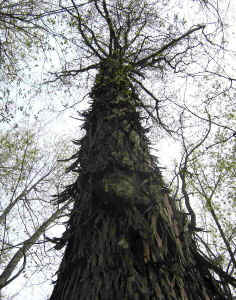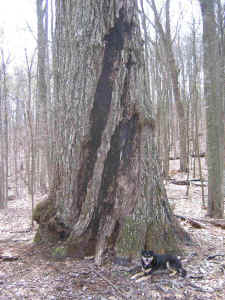|
==============================================================================
TOPIC: The Oldest 1/4 Acre in Tennessee
http://groups.google.com/group/entstrees/browse_thread/thread/a1cb16a24338b03a?hl=en
==============================================================================
|
== 1 of 5 ==
Date: Fri, May 2 2008 2:25 pm
From: Josh
Dear ENTS,
Recently, I have been spending some time in and around Shady Valley
and the Beaverdam Creek Watershed. Shady Dolomite is the name-sake
of
Shady Valley and forms the bedrock of the broad flats at the head of
Beaverdam Creek. Other metasedimentary rocks form Holston and Iron
Mountains that are the ridges around the watershed. Shady Valley is
renowned for its remnant cranberry bogs and for the amazing white
pine
forest that once grew there. Until 1905, this forest consisted of
white pines that had up to 10 16 foot saw logs in them (160 feet of
saw log). The forest at the western end of the valley is said to
have
sawn up to 150,000 board feet to the acre when it was logged between
1905-1910. Unfortunately, the valley is now totally agriculturalized
with a few remnant bogs in ownership of the Nature Conservancy.
The ridges around Beaverdam Creek are managed by Cherokee National
Forest which owns over 23,000 acres in the watershed. Cherokee
National Forest is proposing an 800 acre logging project targetting
90-100 year old mixed mesophytic forests that are found on a
remarkable variety of topographic positions and aspects due to the
geology, climate and latitude of the area. About the only positive
thing about this timber sale is that Cherokee National Forest has
agreed to recognize any old-growth forests I can show them that meet
their protocols. This recognition would give these forests full and
possibly permanent protection under the current Cherokee Forest
Plan.
Unfortunately, the agency relies on an arbitrary definition of old-
growth that requires 30 trees per acre over 140 years in age for
hardwood types, and this density of old-trees is determined with a
standard forestry plot and a 10 BA prism that equates tree size with
tree age, which most of us know is a bogus concept for old-growth,
as
is, in my opinion, the concept of an average density of old-trees
per
acre.
Never-the-less, I have been using this protocol to collect data in
several patches of primary forest that is dominated by chestnut oak.
In one of my plots I got quite a surprise. I cored six trees with
the
following results:
Red Maple 20" dbh - 95 rings to a hollow center
Chestnut Oak 22" dbh - 176 rings
Chestnut Oak 26" dbh - 316 rings
Chestnut Oak 26" dbh - 359 rings
Chestnut Oak 31" dbh - 381 rings
Chestnut Oak 34" dbh - 371 rings
In one plot I found three of the five oldest trees I've ever cored!
The title of this post is hyperbolic: I'm sure there is an older 1/4
acre in TN and perhaps Neil, Will, or Jess have found it. I do think
the density of old chestnut oaks in this spot is quite notable.
Tellingly, this plot did not meet the 30 old trees per acre
criterion
that the Forest Service uses to define old-growth on Cherokee NF.
This site is also interesting because it does not fit the "age
with
adversity" principle. This site is about as good as it gets for
chestnut oak. It sits on a concave, northwest facing slope just
above
an acidic cove forest dominated by hemlock and poplar at 3200'
elevation. Above this site, the forest becomes much drier and fire
prone, but this spot has not had a severe wildfire for many
centuries.
 Shagbark Hickory
Shagbark Hickory
Also of note to ENTS are a couple of nice trees I encountered. One
was an ENOURMOUS remnant shagbark hickory in an flat, east facing
cove. It is growing right beside a spring. I measured it to 10.6'
cbh and 146.6' tall with laser and sine. This is easily the largest
and tallest shagbark I have ever seen! My range finder only reads in
even numbers so I knocked a yard off of each of my measurements,
thus
this is probably a conservative measuring.
 big Red Oak
big Red Oak
I also came across a northern red oak on a ridge that was 15.97' cbh.
Josh Kelly
|

Shagbark Hickory stitch: 10.6' cbh x 146.6' tall and the northern red is
15.97' cbh |
== 2 of 5 ==
Date: Fri, May 2 2008 2:50 pm
From: DON BERTOLETTE
Josh-
Your post set me to thinking about an area on a topo map of a small
portion of the south fork of the Trinity River in N. California
called Hell's Half-Acre!
But I digress, I was going to comment on age due to diversity you
mentioned for the chesnut oak site...I could be wrong, and there are
sure to be posts if so, but it's my understanding that one of the
more significant differences between conifers and deciduous trees is
that hardwood trees like oaks add strength proportional to the width
of the annual ring, whereas conifers in general will decrease
strength with increased annual increment (they're liable to get
brash). The fact that your chesnut oaks were on an excellent site,
would be consistent with large circumferences (increased annual
increments).
Physiologically, the strength of the conifer (softwood) comes from
the proportion of winter wood (high in lignin) which happens with
diminished annual increment (brought about by diversity). The
strength of hardwoods is due to medullary rays and other cellular
level components of the summerwood.-Don
== 3 of 5 ==
Date: Fri, May 2 2008 5:16 pm
From: "Edward Frank"
Josh,
Excellent report. It sounds like a really neat place to visit. I
wish there was something that could be done to implement a more
inclusive definition of old growth so these areas might have some
better protection in their forest management plan. Is there some
other definition for old growth published elsewhere in the US Forest
Service literature that might be more appropriate for defining old
growth on the site? They might consider it if there was an official
definition in the government literature they could use.
Those are impressive ages for the chestnut oak! The oldest official
number of the Old-List is 427, but these are certainly in the
exceptional age category...
Ed
== 4 of 5 ==
Date: Fri, May 2 2008 5:58 pm
From: Josh
Don,
You are exactly right about spring growth in oaks - the porous
nature
of spring wood makes it weaker. The longest of these cores is
16", so
the 381 ringed specimen still averages 23.8 rings per inch. One
interesting thing about these trees is that there is no sign, other
than deeply furrowed bark and thick limbs that they are old. I
thought they would be 250ish.
Josh
==============================================================================
TOPIC: The Oldest 1/4 Acre in Tennessee
http://groups.google.com/group/entstrees/browse_thread/thread/a1cb16a24338b03a?hl=en
==============================================================================
== 1 of 1 ==
Date: Fri, May 2 2008 7:29 pm
From: "Will Blozan"
Josh,
Excellent finds! Sorry you have to be restricted by that asinine
requirement
for OG- how do you remain sane?
That hickory is way big! Definitely worth a return trip to nail the
height
down. Possibly a TN champion?
Will
==============================================================================
TOPIC: The Oldest 1/4 Acre in Tennessee
http://groups.google.com/group/entstrees/browse_thread/thread/a1cb16a24338b03a?hl=en
==============================================================================
== 1 of 4 ==
Date: Sat, May 3 2008 5:55 am
From: Larry
Josh,
Great report! Can't wait to see those photos, we have very few
Chestnut Oaks down here in South Ms. I know of one in Ocean Springs,
at Gulf Islands National Seashore Park. We used to gather acorns
from
it. Last year it produced very few, and the tree looked stressed.
I'd
love to core it just for growth comparison in this less fertile
area.
Its not real big, but I'll go by and measure it. Larry
== 2 of 4 ==
Date: Sat, May 3 2008 10:52 am
From: "Neil Pederson"
Josh,
Cool stuff, though sad/bogus that this clump of old chestnut oaks
does not
qualify as OG.
Maybe your title is hyperbolic, but perhaps not. It would be neat to
try to
find stands with similar densities. I bet there might be a place in
the
Smokies with something similar. Maybe not. Savage Gulf might be
another
comparable place in TN.
Your finding reminds me of the stand in northern NJ that has two
chestnut
oaks over 425 [the oldest one was alive last time I saw it making it
429
yrs, which was in 2005]. Anyhow, this stand had two other chestnut
oaks over
400 yrs, thought both had recently died [one was a tip-up]. I
marveled over
the density of 400+ yr old chestnut oaks in such a small area. This
stand,
however, was not a dense as yours - it is somewhere near +/- 10
acres at
most. It also reminds me of another place I sampled in the G.
Washington
National Forest. Though 30-40 acres, this stand (Fiddler's Green)
had, for a
year, the oldest well-documented individuals for 3 species and one
of the
older northern red oaks. It certainly makes me wonder when I hear of
dense
pockets of old trees.
Very cool!
Related: Ed, I actually do not think 427 is the extreme age for
chestnut
oak. The density of the 400+ yr old trees in N NJ and the frequency
of
300-400+ yr old chestnut oaks along the Appalachian Mtns [Eastern
OLDLIST
still isn't complete, esp for some well-sampled species] suggests
that this
is not an unusual age. As the oldest white oak is currently set at
464 and
there are numerous similarities between white & chestnut oak, I
expect that
a 450+ yr old chestnut oak will be documented.
neil
== 3 of 4 ==
Date: Sat, May 3 2008 10:59 am
From: "Neil Pederson"
All,
I neglected to mention the similar stand of tulip-poplar along Forge
Creek
in the Smokies. Though not the 1/4 acre size Josh mentions, the
ability to
experience a stand of 300-500 yr old tulip-poplars within a mile
hike
appears to be unusual for the species.
neil
== 4 of 4 ==
Date: Sat, May 3 2008 11:19 am
From: James Parton
Neil,
Is this where that Tuliptree that you found to be over 500 years old
is located? I would love to see that one for myself. I bet BVP would
love this one!
JP
==============================================================================
TOPIC: Shagbark and Red Oak from Shady Valley, TN
http://groups.google.com/group/entstrees/browse_thread/thread/da31ff215b2cac91?hl=en
==============================================================================
== 1 of 2 ==
Date: Sat, May 3 2008 6:42 am
From: "Josh Kelly"
I figured out that if I email the list rather than posting to the
list, I
can attach files.
The shagbark is 10.6' cbh x 146.6' tall and the northern red is
15.97' cbh
and quite short.
Enjoy,
Josh
== 2 of 2 ==
Date: Sat, May 3 2008 7:12 am
From: Gary Smith
Nice photos, Josh.
I don't know much about shagbark hickory, their southernmost range
looks like it is roughly 50 miles north of me. Going to have to look
for some the next time I head north, that bark looks awesome.
gs
==============================================================================
TOPIC: The Oldest 1/4 Acre in Tennessee
http://groups.google.com/group/entstrees/browse_thread/thread/a1cb16a24338b03a?hl=en
==============================================================================
== 1 of 2 ==
Date: Sat, May 3 2008 11:19 am
From: James Parton
Neil,
Is this where that Tuliptree that you found to be over 500 years old
is located? I would love to see that one for myself. I bet BVP would
love this one!
JP
== 2 of 2 ==
Date: Sat, May 3 2008 11:48 am
From: "Will Blozan"
Neil,
There is a chestnut oak I cored in 1993 that was 398 years (not
cross-dated;
ring count). If still alive it would be ~413 years at 4.5 feet. It
was tiny,
too- less than 30 inches dbh. Maybe it was on one of the core boards
you
grabbed in the park last year?
Will
|